Misled by Nature at the MOCCA, an exhibition organized by the National Gallery of Canada and the Art Gallery of Alberta, presents a small selection of works overwhelming in detail and ornateness. The show is comprised of artworks from the National Gallery’s permanent collection featuring the artists David Altmejd, Mark Bradford, Lee Bul, Bharti Kher, Tricia Middleton, and Yinka Shonibare, MBE.
The exhibition explores the themes that have come to define the art of the Baroque in the seventeenth century such as of extravagance, theatricality, and opulence. It examines how contemporary artists have incorporated these themes into their work as well as cultural issues that surround the Baroque era within the contemporary context. The title of the exhibition, Misled by Nature, implies a world that has been misguided by sensual delights, appealing to both our visual and tactile senses. Like the art of the Baroque era, this exhibition is intended to stir the senses of the viewer.
The central space of the gallery is occupied by three large-scale, mixed media installations. All of them have reflecting surfaces on or around them, mirroring the space that each occupies so while looking at them the viewer is also observing the space around the work. Although they are clearly separated from one another, it is as if these installations are growing and absorbing the surrounding gallery space.
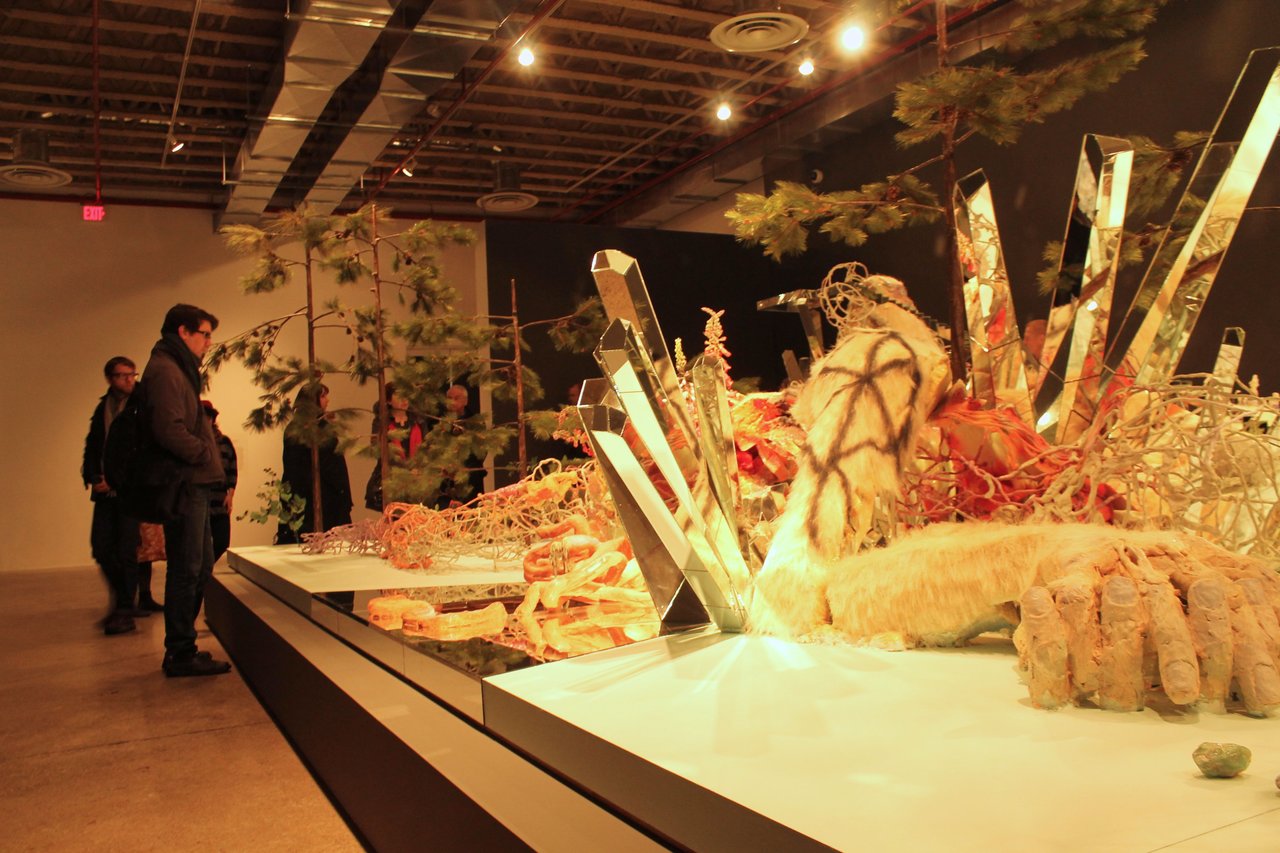 David Altmejd, The Holes, 2008, wood, mirror, glue, plaster, foam, metal wire, epoxy clay, epoxy resin, paint, horse hair, synthetic branches, synthetic flowers, pine cones, glass beads, quartz, quail eggs, glitter, and snail shells, 291.5 x 883.9 x 518.2 cm, detail, National Gallery of Canada
David Altmejd, The Holes, 2008, wood, mirror, glue, plaster, foam, metal wire, epoxy clay, epoxy resin, paint, horse hair, synthetic branches, synthetic flowers, pine cones, glass beads, quartz, quail eggs, glitter, and snail shells, 291.5 x 883.9 x 518.2 cm, detail, National Gallery of Canada
 David Altmejd, The Holes, 2008, wood, mirror, glue, plaster, foam, metal wire, epoxy clay, epoxy resin, paint, horse hair, synthetic branches, synthetic flowers, pine cones, glass beads, quartz, quail eggs, glitter, and snail shells, 291.5 x 883.9 x 518.2 cm, detail, National Gallery of Canada
David Altmejd, The Holes, 2008, wood, mirror, glue, plaster, foam, metal wire, epoxy clay, epoxy resin, paint, horse hair, synthetic branches, synthetic flowers, pine cones, glass beads, quartz, quail eggs, glitter, and snail shells, 291.5 x 883.9 x 518.2 cm, detail, National Gallery of Canada
The first work that visitors encounter is David Altmejd’s The Holes, is an installation composed of a diverse range of materials including glass, fake flowers, pine cones, glass beads, quartz, quail eggs, glitter, and snail shells. It resembles an opulent, grotesque, and fantastical landscape. Although all of these objects appear to be growing out of the base it is clear that all these materials are artificial. Mirrors in the shape of prisms stick out like quartz in a dark cave. The glass surfaces reflect multiple views of the installation and the gallery space within the work.
 Lee Bul, After Bruno Taut (Negative Capability), 2008, crystal, glass, and acrylic beads on stainless steel armature with aluminum and copper mesh, with chains made of PVC, steel, and aluminum, 274.3 x 296.4 x 213.4 cm, National Gallery of Canada
Lee Bul, After Bruno Taut (Negative Capability), 2008, crystal, glass, and acrylic beads on stainless steel armature with aluminum and copper mesh, with chains made of PVC, steel, and aluminum, 274.3 x 296.4 x 213.4 cm, National Gallery of Canada
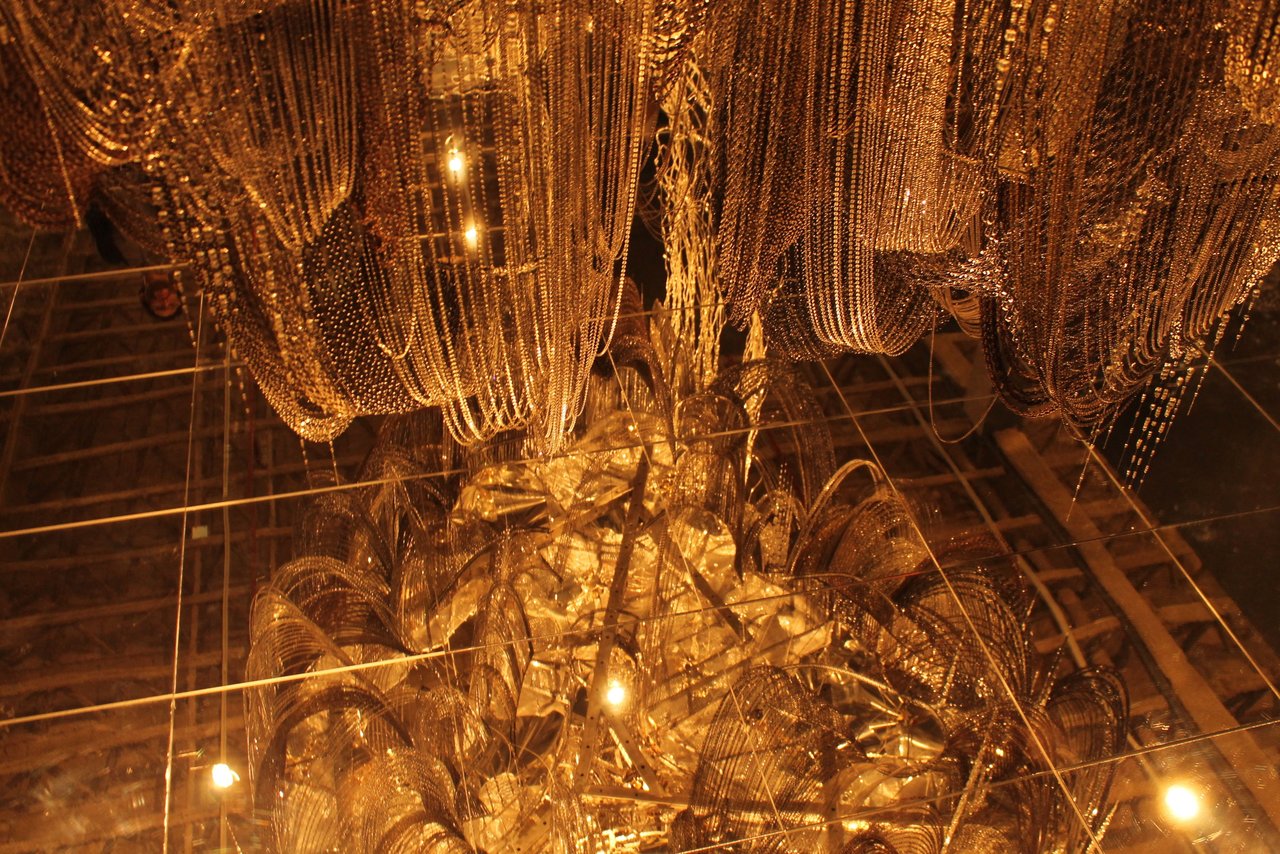 Lee Bul, After Bruno Taut (Negative Capability), 2008, crystal, glass, and acrylic beads on stainless steel armature with aluminum and copper mesh, with chains made of PVC, steel, and aluminum, 274.3 x 296.4 x 213.4 cm, detail, National Gallery of Canada
Lee Bul, After Bruno Taut (Negative Capability), 2008, crystal, glass, and acrylic beads on stainless steel armature with aluminum and copper mesh, with chains made of PVC, steel, and aluminum, 274.3 x 296.4 x 213.4 cm, detail, National Gallery of Canada
Lee Bul’s ornate installation, After Bruno Taut (Negative Capability) is constructed from industrial materials such as steel, glass, beads, aluminum, and copper. It is suspended from the ceiling and glitters like a chandelier. The dramatic effect of this work is intensified by the mirrored floor placed beneath it, inviting viewers to observe the details through the reflection of the floor as well. The themes and materials of this work were influenced by the ideas of the Utopian architect Bruno Taut who was a champion of Modernist industrial architecture. Bul has translated Taut’s ideas through her use of industrial materials and her construction of a Utopian model for an idealized built world, creating an imaginary world that is delicate, idealized and manufactured.
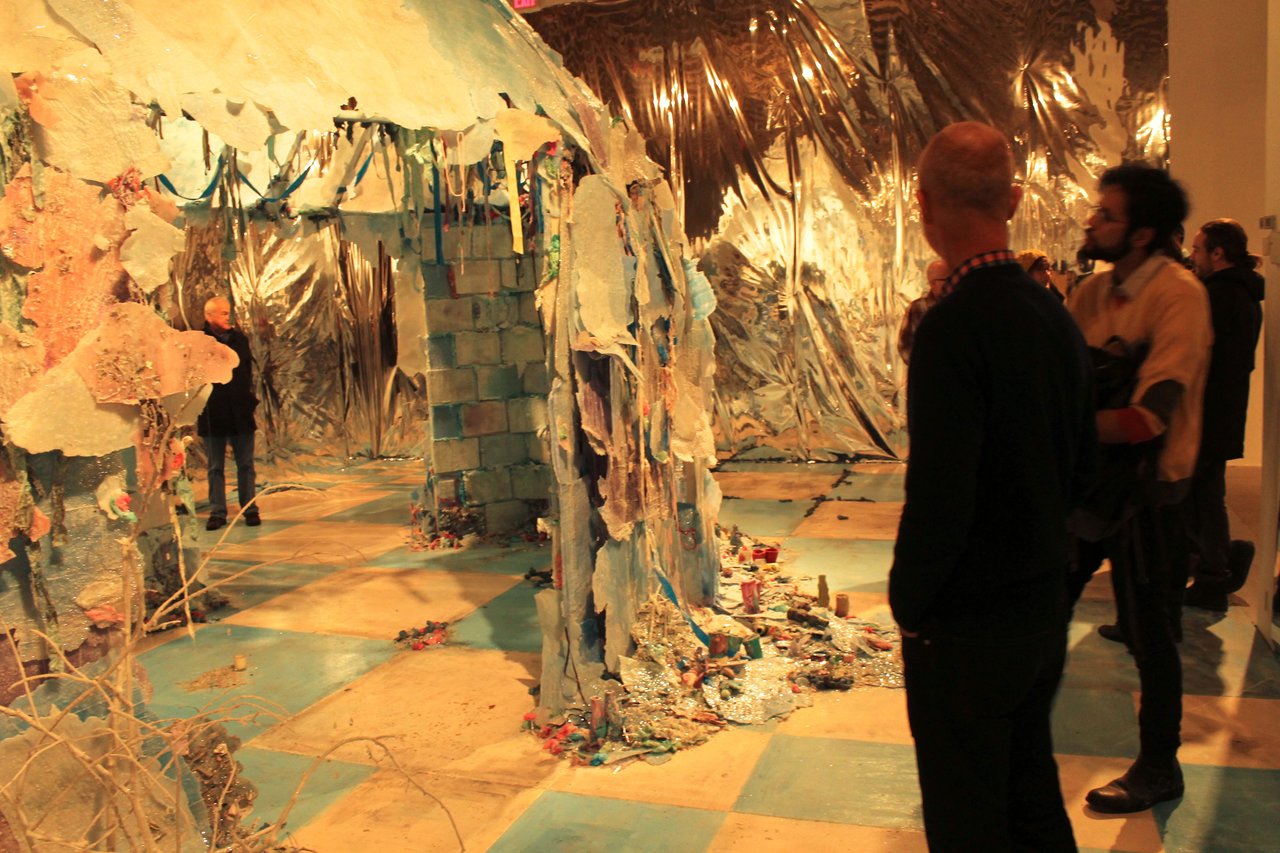 Tricia Middleton, Embracing ruin and oblivion is the only way to live now, 2012-2013
Tricia Middleton, Embracing ruin and oblivion is the only way to live now, 2012-2013
The lights in the gallery are dimly lit projecting a warm golden glow onto the installations. This warm lighting contrasts with the cool colours of Tricia Middleton’s installation Embracing Ruin and Oblivion is the Only way to Live Now, which is a dome structure painted in frosted pastel blues and pinks and dusted with sparkles.
Three works are displayed in the second room of the museum, no less intricate. They comment on the culture and society of Europe in the seventeenth and eighteenth century, and particularly issues surrounding colonialism that followed the age of exploration. Mark Bradford’s mixed media collage on canvas, Africa is intended to reflect historical Baroque maps. European maps of Africa during the seventeenth century would have been greatly linked to the slave trade. Bradford has created thick interconnected lines running in all directions throughout the canvas. These lines appear to map out a network trade routes that would have existed for the purpose of trafficking slaves.
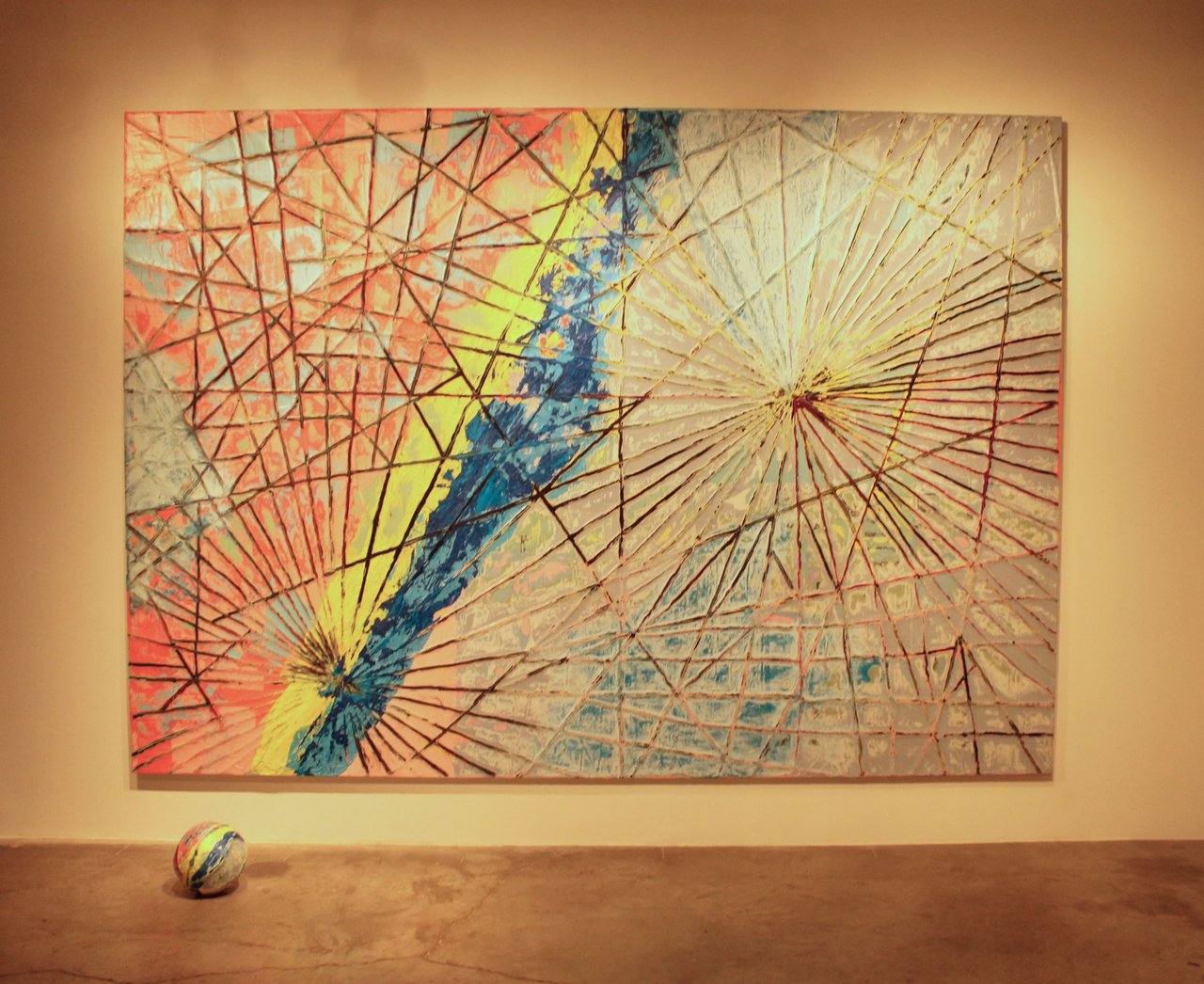 Mark Bradford, Africa, 2013, Mixed media on canvas, papier mache and collage: 2 parts: 102 × 144 cm, 259.1 × 365.8 cm
Mark Bradford, Africa, 2013, Mixed media on canvas, papier mache and collage: 2 parts: 102 × 144 cm, 259.1 × 365.8 cm
Yinka Shonibare, MBE, Mr. and Mrs. Andrews without their Heads, involve two headless mannequins fashioned in eighteenth century aristocratic dress and posed after Thomas Gainsborough’s painting of the same title from 1750. Shonibare has dressed these mannequins in eighteenth century style costumes made of batik fabric that would have been traded by European merchants. Shonibare is commenting on the material excess of society at the expense of others.
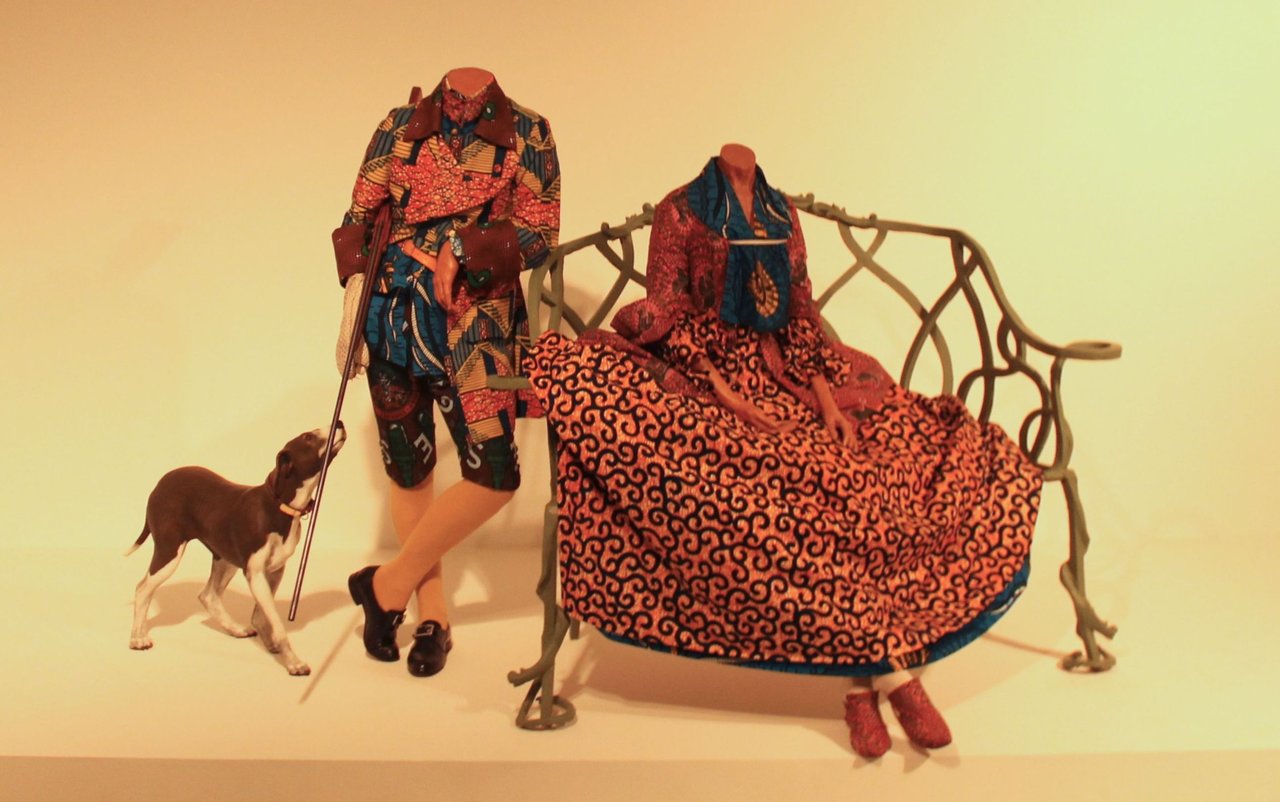 Yinka Shonibare, MBE, Mr. and Mrs. Andrews without their Heads, 1998. Wax print cotton costumes on mannequins, dog mannequin, painted metal bench, rifle, 165 x 635 x 254 cm with plinth, National Gallery of Canada
Yinka Shonibare, MBE, Mr. and Mrs. Andrews without their Heads, 1998. Wax print cotton costumes on mannequins, dog mannequin, painted metal bench, rifle, 165 x 635 x 254 cm with plinth, National Gallery of Canada
Bharti Kher ‘s Nothing Marks the Perimeter, Just a Hollow Sound Echoes, is triptych mosaic composed of thousands of glittering bindis. The bindis in all three panels are meticulously arranged forming an organic yet nonrepresentational landscape. Kher compares the abstract forms of this triptych to both an unknown yet understandable language and an imagined landscape.
This show has brought together elements of fantasy and artifice combined with issues of excess and exploitation. Rather than being misled by nature, one could say that this exhibition presents a world that has gone against nature.
Text and photo by Alice Tallman
*Exhibition information: Misled by Nature: Contemporary Art and the Baroque. February 8 – April 6, 2014, Museum of Contemporary Canadian Art, 952 Queen Street West. Gallery hours: Tue – Sun: 11 – 6 p.m.
